 One need only glance at a CCC camp location map to realize Idaho had a lot of CCC camps and a lot of those CCC camps were Forest Service camps. The Annual Reports also bear this out. For example, Appendix C of The Annual Report of the Director of Emergency Conservation Work for fiscal year 1937 breaks down the average distribution of CCC camps by state and by technical service. Here’s the average for Idaho for FY1937:
One need only glance at a CCC camp location map to realize Idaho had a lot of CCC camps and a lot of those CCC camps were Forest Service camps. The Annual Reports also bear this out. For example, Appendix C of The Annual Report of the Director of Emergency Conservation Work for fiscal year 1937 breaks down the average distribution of CCC camps by state and by technical service. Here’s the average for Idaho for FY1937: National Forest camps: 33
State Forest camps: 5
Private Forest camps: 1
Soil Conservation camps: 5
State Park camps: 1
It should be noted that there is a discrepancy in this particular chart (Appendix C) in that the total number of camps listed for all services is 51 but the total number of camps in Idaho if you simply add up the totals for each service was 45. Likely this is due to the fact that the compiler or editor mistakenly listed the total number of Department of the Interior camps in Idaho as 7, when in fact the number should be just one (the sole State Park camp).
While we’re on the subject of camp types in Idaho, let’s look at the distribution of camps by service type for fiscal year 1939. Appendix H of The Annual Report of the Director of the Civilian Conservation Corps for fiscal year 1939 breaks down Idaho’s CCC camp distribution like this:
National Forest camps: 30
State Forest camps: 3
Private Forest camps: 1
Soil Conservation camps: 4
Bureau of Reclamation camps: 4
State Park camps: 1
Division of Grazing camps: 10
In this case, the Annual Report seems to be without error, as the total number of camps listed for all services is 53, which matches the total listed individually.
Comparing the two years, we see that while the U.S. Forest Service and the state forest each lost camps, Idaho gained a total of 8 camps altogether, in large part due to the establishment of Bureau of Reclamation and Division of Grazing camps. And just what did Idaho gain from the CCC? Thankfully we’ve got Perry Merrill’s book Roosevelt’s Forest Army to turn to for some details, and the camp total seems to compare favorably with the available Annual Reports. Merrill notes that an average of 51 CCC camps operated in Idaho. The aggregate number of Idaho men who gained work as a result of the CCC was 28,074, which included 20,292 junior and veteran enrollees, 1,038 Indian and 6,744 non-enrolled personnel. Merrill also points out that 86,775 individuals from all states worked in Idaho between 1933 and 1942. This means of course that many of the CCC enrollees who worked in Idaho were brought in from other states.
Merrill’s list of work accomplishments indicates the CCC built 236 lookout houses and towers, 91 impounding and large diversion dams and that they strung just over 3,000 miles of telephone lines.
Let’s take a closer look at individual work accomplishments listed in the 1939 Annual Report. The list shows that, among other things, the CCC was responsible for the following improvements in Idaho during fiscal year 1939:
Vehicle bridges: 31
Garages: 10
Latrines and Toilets: 47
Lookout houses and towers: 18
Camp stoves and fireplaces: 68
Cattle guards: 202
And the report shows that from mid 1938 to mid 1939, the CCC spent an astonishing 20,286 man-days fighting forest fires in Idaho!
Comparing just one improvement type – construction of cattle guards – between 1937 and 1939, we might get a snapshot of what it meant to have an increase in the number of Division of Grazing camps between these two reporting periods. In fiscal year 1937 when there were no Division of Grazing camps operating in Idaho, the Annual Report shows that 30 cattle guards were constructed in the state. Two years later, with 10 Division of Grazing camps now operational, the number jumps to 202. (There was also an increase in the number of corrals constructed, with 7 corrals built by the CCC in 1937 compared to 11 corrals built in 1939.) Admittedly, these figures represent a tiny fraction of the statewide work done but comparing them from year to year helps us understand what it meant to have particular technical services working in a state. Fewer Division of Grazing camps in Idaho meant fewer cattle guards and corrals built in Idaho.

Comparisons like this are less useful in sizing up the number of man-days spent fighting forest fires. Recall that in the 1938-1939 reporting period, the CCC spent 20,286 man-days fighting forest fires in Idaho. Two years earlier, during the period 1936-1937, the CCC spent more time (26,020 man-days) fighting fires. This might be due to the fact that there were more forestry-related CCC camps in the state during the 1936-37 time frame (five more forestry camps operated in Idaho in FY1937 than in FY1939) but it might also be due to the fact that there were fewer fires to fight one year versus the other, or that crews were better trained two years later and thus fires were brought under control more quickly. What seems clear now is that over the lifetime of the CCC, the United States saw a steady decline in the numbers of acres lost to wildland fire, but that is a topic for another time.
 The Federal Security Agency Annual Report of the Director of the Civilian Conservation Corps for Fiscal Year 1942 includes some interesting and detailed summaries of CCC work projects that are often overlooked by current historians. The report includes a section entitled “CCC Camps and the Bureau of Animal Industry.” Turns out there were six Bureau of Animal Industry CCC camps scattered across the United States and one of them was located in Dubois, Idaho. The report explains that the Animal Industry stations were research facilities established for the purpose of finding better breeding, feeding and management practices for domestic farm animals and poultry. Referring specifically to the station at Dubois, Idaho, the report goes on to state:
The Federal Security Agency Annual Report of the Director of the Civilian Conservation Corps for Fiscal Year 1942 includes some interesting and detailed summaries of CCC work projects that are often overlooked by current historians. The report includes a section entitled “CCC Camps and the Bureau of Animal Industry.” Turns out there were six Bureau of Animal Industry CCC camps scattered across the United States and one of them was located in Dubois, Idaho. The report explains that the Animal Industry stations were research facilities established for the purpose of finding better breeding, feeding and management practices for domestic farm animals and poultry. Referring specifically to the station at Dubois, Idaho, the report goes on to state: "The CCC camps happened to come when the unusual assistance which they could give was sorely needed at several stations. For example, at Dubois, Idaho, a Bankhead-Jones Special Research project had just been added to this Bureau’s regular appropriation for sheep research. This made necessary a two to three-fold expansion in the research facilities at that station. This meant the opening up of additional land, construction of roads and trails, major extensions of the water and sewerage systems, and extensive landscaping around new laboratory buildings and dwellings. Not without such a unit as a CCC camp, bringing its special equipment and its own housing could it have been possible to equip this plant for the enlarged program so quickly with such small cost to the Government, or so smoothly and well."
You can access an online listing of Idaho’s CCC camps here. (The list is taken from the camp list at the CCC Legacy website.) You’ll note that the Bureau of Animal Industry camps were designated by the letter “A.”
The 1942 Annual Report also includes mention of Idaho CCC enrollees hired by lumber producers: “Sixty-eight CCC boys were hired from one camp in Idaho by a Boise company in four months and this company had over 500 former CCC’s on their payrolls at Pacific Island bases where the Japanese started hostilities in December 1941.”
 In 1934 the American Forestry Association published a small book entitled Youth Rebuilds: Stories from the C.C.C. The book is a collection of personal narratives written by CCC enrollees across the United States and it includes a story entitled “The Next Ridge to the West,” written by Henry F. Vicinus, an enrollee in Company 1276 at Camp F-48, Clarkia, Idaho. In his life before the CCC, Vicinus was a newspaper reporter and his narrative is especially well written. Here are some excerpts from Vicinus’s story.
In 1934 the American Forestry Association published a small book entitled Youth Rebuilds: Stories from the C.C.C. The book is a collection of personal narratives written by CCC enrollees across the United States and it includes a story entitled “The Next Ridge to the West,” written by Henry F. Vicinus, an enrollee in Company 1276 at Camp F-48, Clarkia, Idaho. In his life before the CCC, Vicinus was a newspaper reporter and his narrative is especially well written. Here are some excerpts from Vicinus’s story. Vicinus wrote of his struggles before enrolling:
"Winter came and was little better. The old tuxedo was the first thing to be sold; then the wardrobe trunk, then the camera, all at ten per cent of their value, and finally – my God, what a blow! – the old typewriter. I was no longer a reporter! When “Bel” Hildreth hunted me up to tell me the local CCC quota of men was leaving the next day, he found me on a farm, with my last ragged clothing on my back, and that back nearly broken."
Concerning his time in a conditioning camp, Vicinus recalled:
"Camp Dix was a grand scramble. There was kidding, there was bullying, and each man developed his own little defense to it – some by excelling in the art of kidding and bullying, some by evading it with snappy comebacks, some by going “over the hill.” Never will I forget my nervousness when I first walked up to the orderly tent and suggested myself as a clerk. Nor will I forget the home-coming feeling I had when I first sat down to that little three-bank Underwood and started making rosters. There was something to work at, to occupy my mind, and to do well, looking forward to advancement… Neither will I forget the tense expectancy at the prospect of leaving…once we got the orders to leave for Idaho."
Finally, of his enrollment period in the mountains of Idaho, Vicinus wrote:
"There is, too, something purgative and expansive about the West. One only need stand by a huge tamarack or white pine, look over the valley below him, and gaze miles and miles away where the hazy mountains rise and fall like the waves of a giant ocean….to feel it…And now…it is time to go back to the old surroundings. I shall return not exactly as I left. I have conquered one world. Why should I cower from another?"
To read a section of the online history The Forest Service and the Civilian Conservation Corps that deals with the 9th Corps area and work in Idaho, click here.
Larry Sypolt’s very useful book Civilian Conservation Corps: A Selectively Annotated Bibliography includes references to materials dealing specifically with the CCC in Idaho. In the section on the 9th Corps Area (Washington, Oregon, Idaho, Montana, Utah, Nevada, California and Yellowstone National Park) you’ll see the following source materials listed:
“The CCC in Idaho,” by Judith Austin, Idaho Yesterdays 27 (Fall 1983).
“I’d do it again in a minute!” The Civilian Conservation Corps on the Salmon National Forest, by Michael Crosby, Salmon Idaho, 1997.
Outdoor Idaho. CCC in Idaho. Documentary film by Pat Metzler and Bruce Reichert, 1999.
The work of the CCC in Idaho was not without tragedy. The ruggedness of the country, the frequency of forest fires and the impetuousness of youth thrown together far from home, conspired to take the lives of enrollees in a variety of ways. The April 7, 1935 Edition of the Spokesman-Review reported the death of 25-year old Fred Hunter, an enrollee from Company 245, Chatcolet, Idaho. Hunter died of injuries received “when his motorcycle collided with the concrete rail of the overhead bridge near Lapwai…He was badly crushed.”
The Spokesman-Review also reported on the death of Oscar Kee, an enrollee at the Avery, Idaho CCC camp. 31-year-old Kee was run over and killed by a tractor in March 1935.
There were also instances of boyish exuberance leading to injury, as was reported in a June 1935 issue of the Spokesman-Review. Under the headline, “Bruiser in CCC Tucked in Jail,” the article states:
"Six months is sentence given youth who broke boy’s rib in “initiation.” Cortland Rockwell, 19, was given six months in jail here today by Probate Judge M.G. Whitney, on a charge of battery that developed from an “initiation” at the Ludlow creek CCC camp yesterday. Frank Falk, a rookie being initiated, suffered a broken rib and landed in the Fort George Wright hospital at Spokane when the rough play of the enrollees turned into something more than “monkey business.” He resisted and was set upon by the ringleaders of the “degree team,” bossed by Rockwell, it was said. John Machan, 18, held in the Kootenai county jail here overnight, with Rockwell, as a witness, was released after the trial, but Cecil Sowards, 18, also jailed as a witness yesterday, was held for further investigation."
Finally, the August 24, 1935 issue of the CCC newspaper Happy Days reported on the death of 19-year old Creath Cupp of Huntington, West Virginia, who was killed in a truck accident near Wallace, Idaho. Happy Days reported that Cupp was from Company 565. A photo of the accident site appeared in the Spokane-Review with the following caption: "One man was killed and more than a dozen were injured when the CCC truck shown here drove down a hillside on the Dobson Pass highway near Wallace early Sunday morning, while it was conveying a group of 24 CCC workers back to camp F-150 at Hawk Ranger station from their Sunday holiday in Wallace. The dead man was Creath Cupp, 19 of Huntington, W. Va. Excessive speed on the sharp turn is blamed for the tragedy."



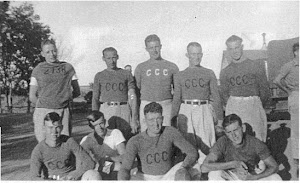

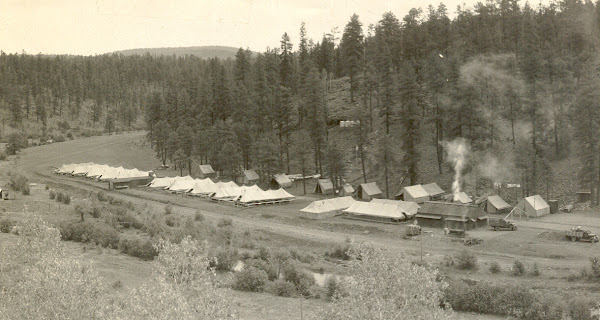

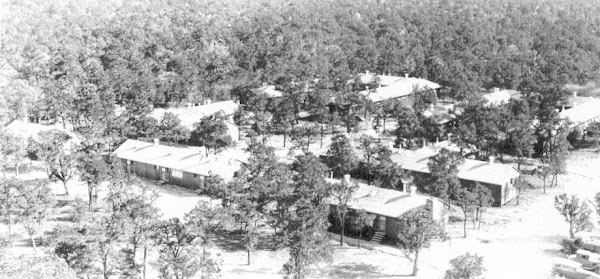



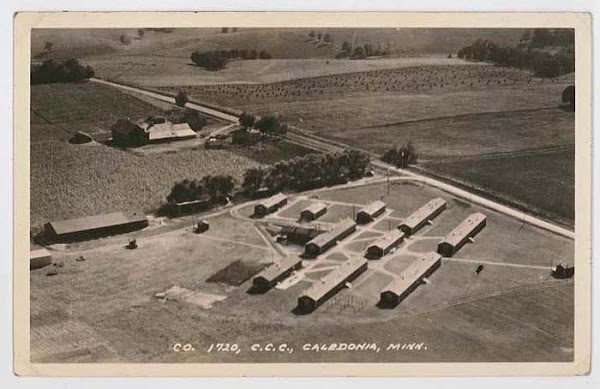
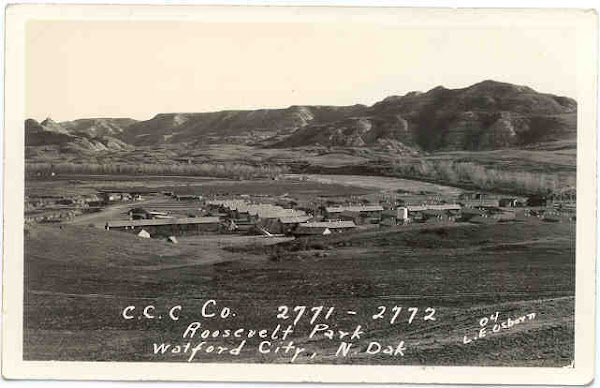
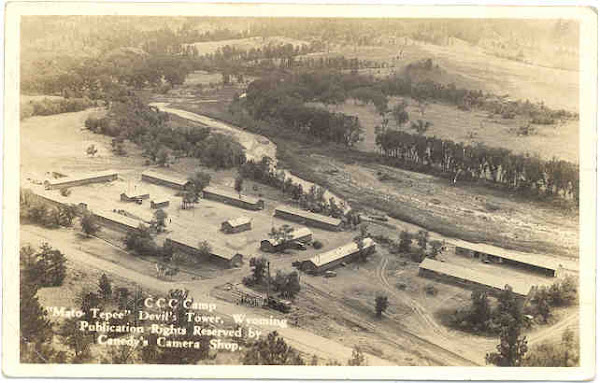
No comments:
Post a Comment